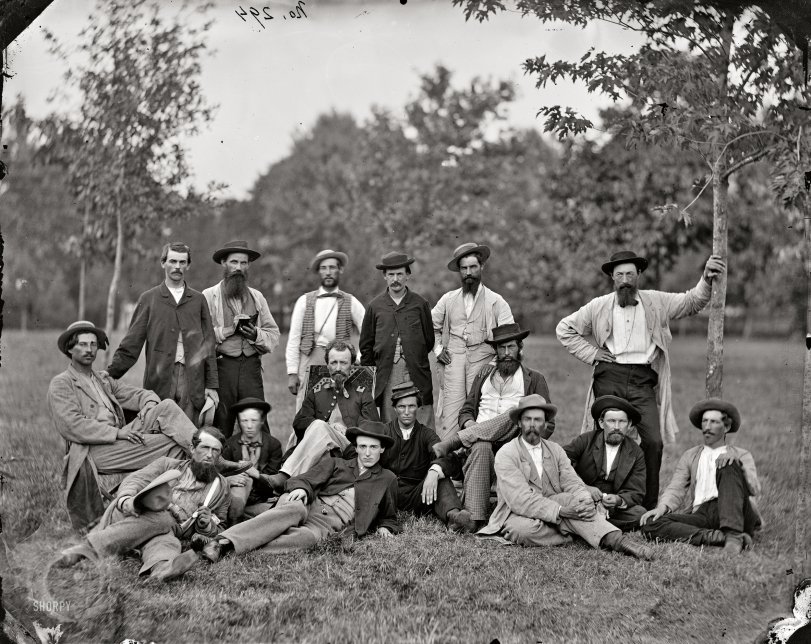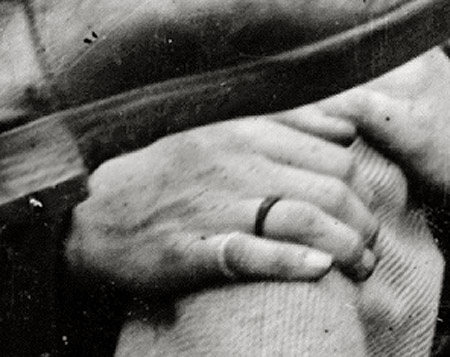


Framed or unframed, desk size to sofa size, printed by us in Arizona and Alabama since 2007. Explore now.
Shorpy is funded by you. Patreon contributors get an ad-free experience.
Learn more.

- Lofty addition
- In 1912
- Keenan Building
- Six years old
- Taken from the P.J. McArdle Roadway?
- It stood only 47 years
- Three track mind
- Incline to the right
- Reach for the sky, 1912 style
- No clean sweep
- Same Job Title, Same Face
- Sadly Lost
- Beautiful ...
- Where you get your kicks
- Aim High
- Pueblo Revival sisters
- Pueblo Neoclassicism
- Milk Man
- Regional dialect.
- Spielberg's inspiration
- Great Photo
- Loaf Story
- Do you still have the Rakes category?
- Could almost be a scene from the 1957 movie 'Hell Drivers'
- The Wages of Fear.
- Conspicuous by their absence
- Got Milk?
- All that aluminum
- No lefties
- Smoke 'em if you've got 'em
Print Emporium
Scouts and Guides: 1864

March 1864. "Brandy Station, Virginia. Scouts and guides of the Army of the Potomac." From photographs of the main Eastern theater of the war, winter quarters at Brandy Station. Standing, left to right: James Doughty, James Cammack (?), unknown, Henry W. Dodd, unknown, unknown. Seated: John Irving, Lt. Robert Klein of the 3d Indiana Cavalry, Dan Cole. On ground: Dan Plue, Lt. Klein's son, W.J. Lee, unknown, Mr. Wood, Sanford Magee, John W. Langdon. Wet-plate glass negative, photographer unknown. View full size.
Union scouts
The man in the chair far left with half a hand, straw hat, is my great-great grandfather JOHN M. IRBY (1840-1871), of the 3rd Indiana Cavalry, Company C. Born and raised in Switzerland County, Indiana. The name "Irving" was incorrectly attributed to him or he possibly used it as an alias. I believe it was misattributed because it so close in spelling to Irby. He suffered the hand injury from a canister shot during a small skirmish (not the large engagement) at Brandy Station, Virginia, in August 1863. He recuperated in Washington, D.C. He detached to Union Headquarters to serve as a scout. Plew (Plue) and Cole were Indiana Third Cavalry.
I was able to verify that he is my ancestor through military, medical and family records. I was able to communicate with his granddaughter who verified much of the information that I learned. John mustered out of the Army in September 1864. His wife was JERUSHA EMILY CULP. They had three children, one being my great-grandfather James M. Irby. John was youngest of three brothers. His brothers were Charles Irby & Silas Irby. They served with Indiana units in the Union Army -- Silas in Tennessee and Charles in Maryland.
John suffered from several medical ailments. He committed suicide by hanging in 1871 in Vermillion County, Indiana. It is said that he was depressed because he could not farm due to his injury. He probably was suffering from PTSD. He is buried in Eugene Cemetery, Eugene, Indiana.
Henry Wood Dodd
He is my relative, born in Fairfield, NJ. Moved to Ohio. His brother Theodore Hale Dodd was a colonel in the Colorado Army; high ranking fellow in the area. Too much to say. Sadly, Henry ate some beef at a Union camp; most got sick. Henry had the sickness the rest of his life. Had to go to the bathroom a lot, if you understand. Hard to stay in the saddle but he did. He was one of the first fellows picked by Pinkerton for the first Secret Service agent's class. Around 1886 or so, Henry was at an old soldiers' home (Kansas ??) but his Iowa sister (teacher) came for him when he was very sick. She was his only family member alive. He died 1888 in Algona, Iowa, aged 49. In 1865, Henry Dodd and another man captured Dick Turner, former Confederate head of Libby Prison. Glen
Scouts and Spies
This picture is on the cover of "Scouts and Spies of the Civil War," by William Gilmore Beymer. These are men who signed up for what was called "extra dangerous duty," behind enemy lines and so forth. Worth a read if you're interested in that sort of thing.
MIA
The gent on the far left appears to be missing a few fingers.

Melungeons
I wonder if some of these fellows are of melungeon heritage. Melungeons are rather dark-skinned people found in the Eastern Appalachians who are generally thought to be of European, Sub-Saharan African and Native American heritage. Some people believe that they were descendants of the Lost Colony, but no one really knows where they came from. "Dodd" and "Cole" are listed as Melungeon surnames, of course those are rather common names, but Mr. Cole is one of the darkest complexioned men in this photo. There's a good article in Wikipedia and loads of other stuff on the Internet on this subject.
That's one tough dude there!
The man sitting with the black and hat the beard is one of the toughest looking fellows I've ever seen. I can see death when I look into his eyes. He is someone I would want on my side!
Most dangerous job
Give these guys a break. An infantry or cavalry scout faces apprehension and summary execution every time he leaves camp. It was a particularly nerve-wracking job in the Civil War, where lines were often fluid, enemy could turn up anywhere, and you might have to bluff your way out of any encounter.
Buttons
Maybe it is the steely eyed look that made it difficult for that guy in the back row to get his waistcoat buttoned up level. Fancy that -- one mistake with the first button and he goes down for internet eternity as a sloppy dresser.
Loud clothes
It's hard to imagine someone discreetly scouting in those outrageous check patterns!
A poet among them?
They are a rough looking bunch, except for the man to the left of center in the grass. He has a "poet" look about him. The others are quite steely-eyed, as has been noted.
These boots were made for either foot
According to some research I did for a sculptor that was working on an Abe Lincoln statue, not long before this picture was taken, footwear was not made with any preference for left and right. These boots are either still in the old style, or fashion hadn't moved them very far away.
I'm guessing....
that the "steely-eyed" look comes from staring into space while trying to hold absolutely still for the long exposures. And, it appears that some were more successful than others at doing this.
Self
Square toed men's dress shoes are still a very popular style in Europe and Asia, but you do not see them so much here in the United States.
Although motley, all of these gentlemen look extremely rugged and competent, which is what you would expect from a guide who could make his way through rugged terrain in all sorts of weather.
The second man from the left in the back is posing writing in his notebook, demonstrating perhaps that he was both professional and literate which would be important marketing points in his favor.
I Just Noticed
Look at the square toes on the boots and shoes. Is that an illusion or am I seeing it right? They've been too long in those clothes, and I'm sure they could all use a bath. But they all also have a steely look in their eyes that you don't see much of any more.
Pinkie rings
I didn't realize that pinkie rings were fashionable (or practical) in those times. I count at least three on left hands and one on right. Does anyone know whether there is any significance to these?

Wow!
I wonder how much time this motley crew spent on the right side of the law and how much time they spent elsewhere.
























On Shorpy:
Today’s Top 5